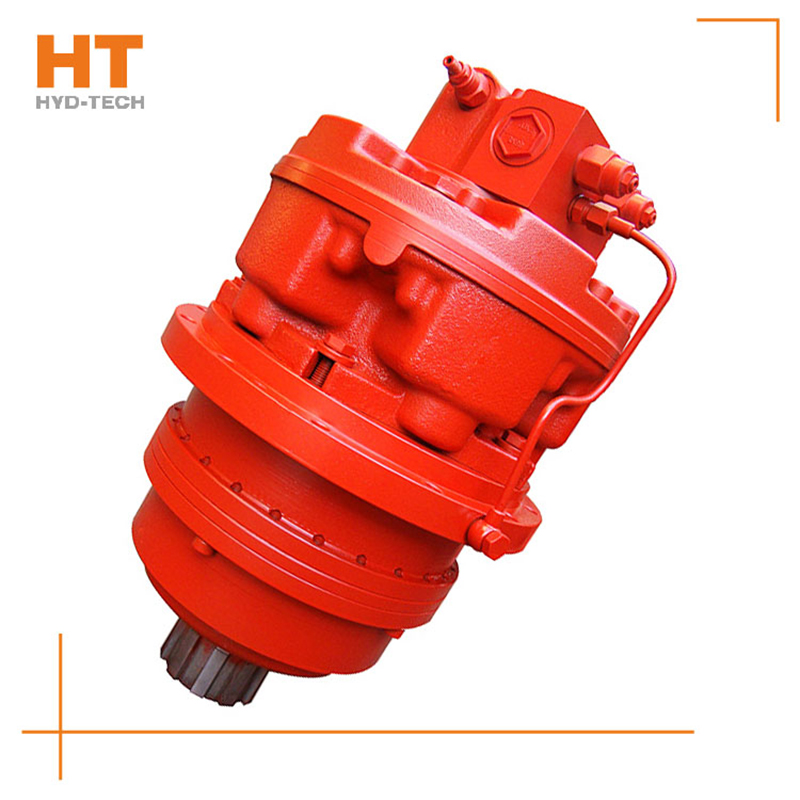Hydraulic motor There are vane type, axial plunger type, radial plunger type and transmission gear type. I will also introduce them to you below. You can compare their differences.
Axial Plunger type hydraulic motor
The principle of the shaft plunger type hydraulic motor is that when the oil pressure enters the bottom end of the plunger in the cylinder through the dialog box of the fixed oil distribution shaft 4, the plunger extends outward. Since there is an eccentric force between the motor stator and the cylinder block, it is firmly pressed on the inner cavity of the motor stator. When the plunger contacts the motor stator, the motor stator will recoil the plunger. The degradability of two forces. When the hydraulic oil pressure at the bottom of the plunger is p, the diameter of the plunger is d, and the intersection angle between the force and the middle is X, the force will cause a torque to the cylinder block to rotate. The cylinder output torque and speed ratio according to the rotating shaft connected with the inner hole.
The condition of torque caused by a plunger analyzed above, because there are many plungers in the oil pressure area, and the torque caused by this plunger makes the cylinder rotate and output torque. Axial plunger hydraulic motor It is mostly used in the condition of low gear and high torque.
General dry construction machinery, agricultural machinery and industrial equipment with low torque mean value. Since the hydraulic motor is generally specified to be capable of forward and reverse rotation, the blades of the vane type hydraulic motor should be placed axially. The principle of the radial plunger motor is that the oil baffle and swashplate are fixed, and the motor shaft and the cylinder block are connected to rotate together. The vane type hydraulic motor is small in size, with small overturning inertia force and dexterous posture. It can be used in places with high commutation frequency, but the leakage is large, and the low-speed gear is not disorderly when working.
Transmission Gear hydraulic motor
。 The greater the tilt angle of the swashplate, the greater the torque and the lower the speed ratio. In order to ensure that there is pressure oil at the blade root from beginning to end, this product should be installed on the channel connecting the return and pressure oil cavities to the blade root. In order to better ensure that the vane hydraulic motor can work normally after the pressure oil is connected, the top of the blade must be closely connected with the inner surface of the motor stator to ensure good sealing performance, and the spring yellow torque should be set at the blade root. If the motor pressure oil typing direction is changed, the motor shaft rotates clockwise.
Vane type hydraulic motor
The transmission gear hydraulic motor has poor dryness and airtightness, low capacity and high efficiency, and the input oil pressure cannot be too high, which cannot cause great torque. In addition, the instantaneous speed ratio and torque change with the change of the position of the meshing point, so the transmission gear hydraulic motor is only suitable for the places with fast and small torque.
Radial plunger motor
Due to the efficiency of pressure oil, the unbalanced bearing force causes the torque of motor rotor. In addition to valve type flow distribution, the radial piston pump can be used as a hydraulic motor under normal conditions, that is, the radial piston pump and the radial piston motor are reversible. When the pressure oil enters the plunger hole of the cylinder block through the dialog box equipped with the oil baffle, the plunger extends under the effect of the pressure oil, and creates a reverse axial force p against the plunger close to the swashplate and swashplate. This force can be degraded into radial force and vertical force Q. The instantaneous total torque caused by radial plunger motor is pulsating.
In order to better integrate the forward and reverse rotation regulations, the gear motor structure type has the same inlet and outlet oil holes, symmetrical, and independent leakage oil holes to lead the leakage oil of the rolling bearing unit out of the housing; In order to better reduce the running friction torque, pop-up rolling bearings are selected; In order to better reduce the torque ripple, the number of teeth of the gear hydraulic motor for beverage transmission is more than that of the pump. Q is in phase with the hydraulic pressure on the plunger, and Q causes the plunger to create a torque in the middle of the cylinder block, pushing the motor shaft to rotate in the opposite direction. The output torque of the vane type hydraulic motor is related to the air displacement of the hydraulic motor and the pressure difference between the inlet and outlet oil holes of the hydraulic motor, and its speed ratio is determined by the total flow size of the input hydraulic motor. Therefore, the vane type hydraulic motor is generally used in places with high speed ratio, small torque and flexible postures. The change of swashplate inclination angle a, that is, the change of air displacement, not only affects the torque of the technician, but also harms its speed ratio and rotation speed.


![]()

